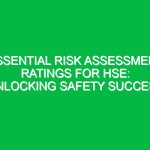In today’s world, where industrial processes and environmental concerns are on the rise, the significance of Health, Safety, and Environment (HSE) practices cannot be overstated. A crucial aspect of HSE management is conducting thorough risk assessments. Understanding the risk assessment steps is vital to ensure the Safety of employees, protect the environment, and comply with regulatory Standards. This article will delve deep into the essential steps of risk assessment within the HSE domain, providing insights, real-life examples, and actionable guidance for successful implementation.
Understanding Risk Assessment in HSE
Risk assessment in the HSE context refers to the systematic process of identifying Hazards, evaluating the risks associated with those Hazards, and determining appropriate measures to control or mitigate those risks. This process is essential for preventing accidents and ensuring a safe and healthy working environment. It also plays a crucial role in environmental protection by identifying potential environmental hazards and their impacts.
The Importance of Risk Assessment Steps
Implementing effective risk assessment steps in the HSE domain is not merely a regulatory requirement; it is a fundamental practice that can lead to significant Benefits:
- Reduction of workplace accidents and incidents.
- Improved employee morale and productivity.
- Enhanced compliance with legal and regulatory requirements.
- Minimized financial losses due to accidents or environmental breaches.
- Strengthened corporate reputation and stakeholder trust.
Key Risk Assessment Steps
To achieve HSE success, organizations must follow a structured approach to risk assessment. Here are the essential risk assessment steps that should be undertaken:
1. Identify Hazards
The first step in the risk assessment process is to identify potential hazards that could cause harm. This could include physical hazards (like machinery), chemical hazards (like toxic substances), biological hazards (like bacteria), and ergonomic hazards (like repetitive strain injuries). Engaging employees in this step can provide valuable insights, as they often have firsthand experience with potential risks.
2. Assess Risks
Once hazards are identified, the next step is to assess the risks associated with those hazards. This involves evaluating the likelihood of an incident occurring and the potential severity of the consequences. Various methods can be used, such as qualitative assessments (describing risks in words) or quantitative assessments (assigning numerical values). Tools like risk matrices can help visualize and prioritize risks based on their severity and likelihood.
3. Control Measures
After assessing the risks, it is crucial to determine appropriate Control Measures. This can involve implementing the hierarchy of controls, which prioritizes methods based on their effectiveness:
- Elimination: Remove the hazard entirely.
- Substitution: Replace the hazard with a less dangerous option.
- Engineering Controls: Isolate people from the hazard (e.g., using machine guards).
- Administrative Controls: Change the way people work (e.g., training or job rotation).
- Personal Protective Equipment (PPE): Provide protective gear to employees.
For example, a manufacturing plant might identify the risk of injury from machinery. To control this risk, they could implement machine guards (engineering control) and require PPE like gloves and Safety Goggles (personal protective equipment).
4. Implement Control Measures
Once control measures are identified, the next step is to implement them effectively. This requires clear communication with employees about the new Procedures and the importance of adhering to them. Training sessions can be valuable here, ensuring that all staff understand how to operate safely and what to do in case of an emergency.
5. Monitor and Review
Risk assessment is not a one-time activity; it requires ongoing monitoring and review. Organizations should regularly evaluate the effectiveness of control measures and make adjustments as necessary. This includes conducting regular inspections, reviewing incident reports, and gathering feedback from employees. Continuous improvement is key to maintaining a safe and compliant workplace.
6. Document the Process
Documentation is a critical component of the risk assessment process. Keeping detailed records helps organizations track their risk assessment steps, control measures implemented, and the outcomes of monitoring efforts. This documentation is not only essential for internal audits but also for demonstrating compliance with legal requirements to regulatory bodies.
Real-Life Example: A Case Study in Risk Assessment
To illustrate the importance of effective risk assessment steps, let’s consider a hypothetical case study of a construction company. This company specializes in high-rise buildings and faces multiple hazards, including falls from heights, equipment-related accidents, and exposure to hazardous materials.
1. **Identify Hazards:** The Safety team conducts site inspections and interviews workers to identify potential hazards. They find that the scaffolding used is inadequate, increasing the risk of falls.
2. **Assess Risks:** The team assesses the likelihood of a fall occurring as high due to the existing scaffolding conditions and evaluates the potential severity as critical, given the height involved.
3. **Control Measures:** To mitigate this risk, the team decides to upgrade the scaffolding (engineering control) and implement a safety Training program for all workers (administrative control).
4. **Implement Control Measures:** The new scaffolding is installed, and all workers undergo training sessions to understand Safe Practices and the use of Fall Protection equipment.
5. **Monitor and Review:** After implementation, the safety team conducts weekly site inspections to ensure compliance and gather feedback from workers about the new procedures. They notice a significant decrease in near-miss incidents related to falls.
6. **Document the Process:** All findings, training records, and incident reports are meticulously documented to demonstrate compliance with HSE Regulations and for future reference.
Regulations and Standards Impacting Risk Assessment Steps
Compliance with regulations is a cornerstone of effective risk assessment. Various international and national standards govern the risk assessment process in the HSE domain. In the United States, the Occupational Safety and Health Administration (OSHA) sets forth guidelines that employers must follow to ensure Workplace Safety. Similarly, the Health and Safety Executive (HSE) in the UK provides frameworks for risk assessment.
It is essential for organizations to be familiar with these regulations and integrate them into their risk assessment steps. For instance, osha’s General Duty Clause requires employers to provide a workplace free from recognized hazards. This reinforces the need for thorough risk assessments and the implementation of effective control measures.
Best Practices for Effective Risk Assessment Steps
Implementing risk assessment steps effectively requires adherence to several Best Practices:
- Engage Employees: Involve employees in the risk assessment process to gain insights and foster a culture of safety.
- Be Systematic: Follow a structured approach to ensure all potential hazards are identified and assessed.
- Communicate Clearly: Ensure that all team members understand their roles and responsibilities regarding safety procedures.
- Stay Updated: Regularly review and update risk assessments to reflect changes in the workplace or operations.
- Invest in Training: Provide ongoing training to keep employees informed about safety practices and new risks.
Conclusion
In conclusion, understanding and implementing effective risk assessment steps is essential for achieving Health, Safety, and Environment success. By identifying hazards, assessing risks, implementing control measures, monitoring effectiveness, and ensuring compliance with regulations, organizations can create a safer workplace for employees and protect the environment.
As industries evolve and new risks emerge, continuous improvement in risk assessment practices will be necessary. Embracing a proactive approach to HSE will not only safeguard employees and the environment but also enhance organizational reputation and performance. Therefore, organizations should commit to these essential risk assessment steps and foster a culture of safety and accountability.


